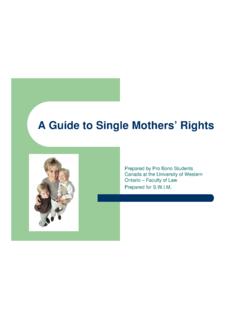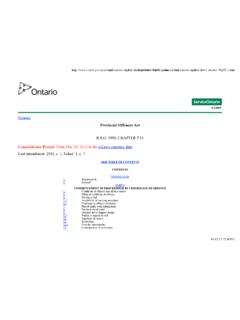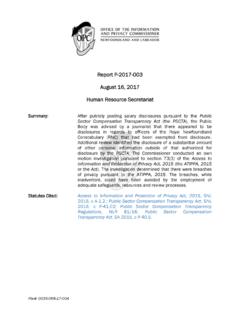Transcription of Success with Limitation Period Defences
1 31st Floor 130 Adelaide Street W est Toronto, Ontario M5H 3P5 Tel: 416-869-0123 Fax: 416-869-0271 Website: Harry P. Brown Marlett Dobson Jennifer Beresford Christopher W hibbs Kate Meyers Benjamin Hutchinson William G. Scott George Tsakalis Jonathan Tatner Andrew Laviolette Sharan Dhami Peter Pietraszek Leilah Edroos Jillian Van Allen Mikhail Shloznikov Philip Ghosh Adam Pennino Success with Limitation Period Defences Canadian Defence Lawyers Accident Benefits CDL Hilton Hotel, Toronto, ON October 15, 2014 Overview What is a Limitation Period defence? Why should I bring a Limitation Period defence? What is the difference between an AB vs. Tort Limitation Period defence? How and when can I bring a Limitation Period defence? How can I actually succeed? What is a Limitation Period defence? When litigating a Statutory Accident Benefits Schedule, Effective September 1, 2010 ( SABS ) denial, there are two fundamental Limitation periods to be mindful of:1 1.
2 Section (1) of the Insurance Act states: Limitation Period A mediation proceeding or evaluation under section 280 or or a court proceeding or arbitration under section 281 shall be commenced within two years after the insurer s refusal to pay the benefit claimed. 1 There are many more SABS Limitation periods including, but not limited to, the rolling Limitation Period of Loss Transfer Claims (see ING v. Markel and Federation v. Kingsway, 2012 ONCA 218), the 60 day Limitation for the commencement of a mediation after a delivered application for mediation (see Cornie v. Security National, 2012 ONSC 905), the seven (7) day limit for providing notice of an intention to apply for benefits ( of the SABS), and those dealing with procedural and reporting guidelines. However, because the Limitation periods found in of the Insurance Act (and of the SABS) are those most commonly encountered, we have chosen to focus on the two-year Limitation Period and its legislated 90-day extension that commence after a benefit denial before the Financial Services Commission of Ontario ( FSCO ).
3 - 2 - 2. Section (2) of the Insurance Act provides for an exception: Exception Despite subsection (1), a proceeding or arbitration under clause 281 (1) (a) or (b) may be commenced, (a) if there is an evaluation under section , within 30 days after the person performing the evaluation reports to the parties under clause (b) if mediation fails but there is no evaluation under section , within 90 days after the mediator reports to the parties under subsection 280 (8). These Limitation periods are also incorporated in the SABS: Time Limit for Proceedings 51(1) A mediation proceeding or evaluation under section 280 or of the Insurance Act or a court proceeding or arbitration under clause 281 (1) (a) or (b) of the Act in respect of a benefit under this Regulation shall be commenced within two years after the insurer s refusal to pay the amount claimed. 51(2) Despite subsection (1), a court proceeding or arbitration under clause 281 (1) (a) or (b) of the Insurance Act may be commenced within 90 days after the mediator reports to the parties under subsection 280 (8) of the Act or within 30 days after the person performing the evaluation provides a report to the parties under section of the Act, whichever is later.
4 Therefore, a mediation and arbitration must be commenced within the two years of the Insurer's refusal to pay. If the mediation, but not the arbitration, was commenced within two years, then the Limitation Period for commencing arbitration is extended to 90 days after the release of the Report of Mediator. What are the benefits of a Limitation Period defence? If available, a Limitation Period defence can be recognized and argued very early in the mediation and arbitration process. It focuses on a narrow issue and, as such, is an ideal - 3 - candidate for a FSCO preliminary motion hearing or a summary judgment motion . A successful Limitation Period defence will result in having the action dismissed. In the proper cases, astute adjusters and their counsel will resolve cases more quickly and more efficiently by pursuing a Limitation Period defence early in a dispute. Tort vs. AB Limitation Period defence The discoverability principle does not apply in the AB An accident benefits applicant has strict timelines to commence a mediation and arbitration following a legal denial of a benefit.
5 If the denial is lawful, the claimant does not have the discoverability principle to fall back on. This issue was addressed by the Court of Appeal in Wadhwani v. State Farm Mutual Insurance The insured returned to work after an accident, then later stopped working because of accident-related injuries. The insured was not allowed to rely on fresh medical findings two years after income replacement benefits were denied to reactivate the Limitation Period and make fresh claims for further benefits. How to get the Limitation Period to start running? 1. In order to trigger the two-year Limitation Period , the denial or stoppage of benefits must be clear and unequivocal .4 2. Secondly, the notice of a refusal to pay benefits must also contain, in straightforward and clear language, directed towards an unsophisticated person, a description of the most important points of the dispute resolution process, such as the right to seek mediation, the right to arbitrate or litigate if mediation fails, and the relevant time limits that govern the entire 2 Section 19 of the Limitations Act specifically excludes the Limitation set by of the Insurance Act from being subject to the Limitations Act.
6 3 2013 ONCA 662; see also, Compton v. State Farm Insurance Company of Canada, 2014 ONSC 2260 at para 30. 4 Zeppieri and Royal Insurance Company of Canada, QIC A-005237, Arbitrator Naylor, February 17, 1994; Turner v. State Farm Mutual Automobile Insurance Company, (2005) 195 OAC 61 (ONCA); Monks v. Dominion of Canada, P09-00018, Director s Delegate Blackman, December 10, 2009. 5 Smith v. Co-operators General Insurance Co., [2002] 2 SCR 129, 2002 SCC 30 at para 14; see also, Sietzema v. Economical Mutual Insurance Company, 2014 ONCA 111. - 4 - In speaking for the Supreme Court of Canada majority in Smith v. Co-operators General Insurance Co.,6 Justice Gonthier wrote on the requirements of a denial: In my opinion, the insurer is required to inform the person of the dispute resolution process contained in ss. 279 to 283 of the Insurance Act in straightforward and clear language, directed towards an unsophisticated person.
7 At a minimum, this should include a description of the most important points of the process, such as the right to seek mediation, the right to arbitrate or litigate if mediation fails, that mediation must be attempted before resorting to arbitration or litigation and the relevant time limits that govern the entire process. Without this basic information, it cannot be said that a valid refusal has been given. The standard OCF-9 forms now relied upon by adjusters all contain wording which satisfies the second requirement, meaning defence counsel need only be concerned with the first requirement. The 90-day Limitation Period extension (2)(b) of the Insurance Act (and (2) of the SABS) provides, in part, that despite the two year Limitation set out in subsection (1), if mediation fails, an arbitration may be commenced "within 90 days after the mediator reports to the parties under subsection 280(8).
8 The controlling date setting the 90-day Limitation in motion is the date on which the parties actually received the Report of Mediator, not the date it was It is appropriate to allow five (5) business days for delivery for the Applicant to have received or be deemed to have received the Mediator s In Kurichh v. Allstate Insurance Co. of Canada, Arbitrator Hale held that the Report of Mediator was deemed received by finding that it defies logic to take the position that letters sent both to counsel and [the Applicant] were not delivered or were not returned to this office as undeliverable .9 6 [2002] 2 SCR 129, 2002 SCC 30. 7 Bhambi v. State Farm Mutual Automobile Insurance Company, A07-001075, Arbitrator Bayefsky, December 20, 2007, at para 20. 8 Ibid. 9 A97-002118, Arbitrator Hale, May 6, 1999 - 5 - Principles of Limitation Period denial a.
9 The denial is not required to be legally correct Although the denial requires a reason for refusing benefits, the reason does not have to be legally correct. The obligation to give reasons is to permit the insured to decide whether or not to challenge the denial. If the reasons given were legally incorrect, the insured is expected to challenge them within the applicable Limitation b. Post-denial negotiations or requests for further information do not restart the Limitation Period Ongoing negotiations or requests for further information between an insured and the insurer do not extend the time limits for disputing an otherwise clear and unequivocal c. There can be no valid refusal where there has not first been a valid election Insureds who are potentially entitled to more than one of income replacement benefits ( IRBs ), non-earner benefits ( NEBs ), or caregiver benefits ( CGBs ) must elect which of the benefits they wish to receive.
10 An election is only valid if an Insurer has met its consumer protection obligations by providing to the insured person information required by legislation for an informed election. No time limit based on an invalid refusal, including the two-year time limit under section 51 of the Schedule and of the Insurance Act, can begin to d. The 90-day Limitation Period is not extended by the issuance of an amendment to a Mediator s Report This is pursuant to Dispute Resolution Practice Code Rules and 23. e. The timelines of the accident benefits Limitation legislation is strictly adhered to Unlike some other time limits contained in the SABS, section 51 is a "hard" limit. As discussed by Arbitrator Wilson in Punwasie v. State Farm Mutual Automobile Insurance 10 Sietzema v. Economical Mutual Insurance Company, 2014 ONCA 111; Turner v.



